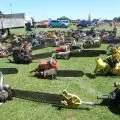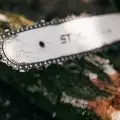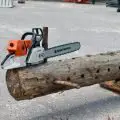An enormous quantity of energy is released as a chainsaw cuts, and a significant portion of that energy is transformed into heat. Chainsaws feature built-in systems that dispense oil to the bar and chain while they cut, significantly lowering friction and the conversion of energy into heat.
This helps to alleviate some of the heat buildups. The heat, however, can build up if the bar stops receiving oil and result in a variety of unpleasant issues, including burning the wood itself. If you find yourself in this circumstance, you need not be afraid.
In this article, we’ll present the reasons why the chainsaw bar not getting oil, along with the steps to take to fix your chainsaw oiler and resume your tasks!
Table of Contents
- What Is a Chain Oiler?
- Why Is My Chainsaw Bar Not Getting Oil
- How to Clean a Chainsaw Oiling System
- FAQs (Frequently Asked Questions)
*Image coming soon – Chainsaw Oiler*
What Is a Chain Oiler?
First things first, let’s define this vital component. Your chainsaw’s chain oiler is a pump that automatically pumps oil into the bar groove, where it is subsequently collected by the chain as it rotates. By ensuring proper lubrication of your chain, the oil helps it slide more smoothly along your bar.
This helps ensure your saw is operating effectively and smoothly. Smoke from your chainsaw is a surefire sign that something isn’t functioning properly if your chainsaw’s oiler isn’t working.
The oiler uses bar and chain oil to lubricate your bar and chain. The tank where this oil is stored is normally located near the front of the saw. It’s important to note that engine oil mixed with chainsaw fuel is not the same as bar and chain oil. Don’t mix up your bar and chain oil with your motor oil; doing so could be disastrous for your saw.
*Image coming soon – a chainsaw with bar and chain oil tank circled*
Why Is My Chainsaw Bar Not Getting Oil
- Insufficient bar oil in the reservoir
- Debris obstruction in the oiling system
- Broken oil pump component
Insufficient Bar Oil in the Reservoir
Regular bar and chain oil refills are necessary for a chainsaw. Since they often deplete at a comparable rate, bar oil should typically be refilled every time the gas tank is topped off.
The first thing you should do if your bar runs out of oil is to see whether there is still any in the reservoir. If you don’t, the solution is as easy as adding additional oil!
Your bar should start getting lubricated regularly once it has been filled back up, but make sure to check the chain tension because it is likely that heat differentials from being run dry loosened or tightened the chain.
Debris Obstruction in the Oiling System
On rare occasions, sawdust may enter the system and obstruct one of the several channels that the oil must pass through. One of the most frequent causes of a bar and chain not receiving oil is this, and the solution is not too difficult.
The oil holes on the bar, the oil dispenser next to the clutch on the exterior of the chainsaw, and the oil intake inside the reservoir are the three main sites that are most likely to be obstructed. Details on how to clean the chainsaw oiling system will follow below!
Learn all about chainsaw oil in our Chainsaw Oil Types Guide!
Broken Oil Pump Component
A “worm gear” that resembles a plastic thread component controls the oil pump. This little component is situated on the crankshaft, behind the clutch and sprocket, as shown in the image below.
*Image coming soon – worm gear thread*
These tiny parts are typically made of plastic (for some strange reason), and they can melt if they get too hot or suffer thread damage if something happens to make them “cross-threaded” during normal saw operation. These gears frequently sustain damage, and if they do, your saw’s entire oiling system may be jeopardized.
If you find that the worm gear is unharmed or that the gear of the oil pump is not freely turning, it is likely the issue is with the oil pump itself and may need to be replaced.
More details on how to test your oil pump are below!
How to Clean a Chainsaw Oiling System
1. Remove the Bar and Chain
Unscrew the cover and take it off to remove your bar and chain. Then rise up and push back to remove your bar and chain. To shield your hands from the chain as you do this, I would advise wearing gloves. Here’s an example of a filthy chainsaw with its cover off.
*Image coming soon – filthy chainsaw*
As you can tell, this chainsaw has lots of gunk inside. When you clean your oiler, I recommend cleaning this inside portion of your saw and cover as well. Especially if it has this much sawdust and grime caked on it.
A good trick is using some old packing paper to wipe it off and a screwdriver to get into all the nooks and crannies. If your gunk isn’t caked on, an air compressor could be a good way to clean it out as well.
2. Clean the Oil Outlet Port
Your oil tank’s oil seeps into the oil hole on your chainsaw bar through the oil outlet port. Sawdust and other debris might clog up this little opening. Your chainsaw’s oil outlet port is right behind the bar as can be seen below.
*Image coming soon – oil outlet port*
3. Clean the Oil Hole and Bar Groove
The chainsaw bar oil hole itself and the chain bar groove need to be cleaned out next. Your chainsaw bar’s oil hole has a little gap, like the one in the image below.
*Image coming soon – chainsaw oil hole*
Using a wire, a small file, or pretty much anything else that will fit inside, you can easily clear this out. Scrape off as much grime as you can.
Note: Keep in mind that chainsaw bars may be turned around, so there is an oil hole on both sides. Be sure to clean both of them.
Your bar groove needs to be cleaned up after that. Even if your oiler is operating flawlessly, the bar groove can become filled with sawdust, which will prevent oil from reaching every area of the chain. Any tool that easily fits into your bar groove can be used to clean this out, including your gauge tool.
Below are before and after images of this step!
*Images coming soon*
4. Reassemble the Saw
You can then reassemble your saw once all of its components have been thoroughly cleaned. Reattach your chain to the bar by sliding it back into position. Ensure that the chain is pointing in the proper direction. Visit our Chainsaw Chain and Blade Direction Guide – the RIGHT way to fit a Chain for more information on this!
5. Test the Oiler
Once everything has been put back together (bar, chain, cover, etc.). Testing your chainsaw to make sure your oiler is now functioning properly is the last thing you need to do. Start your chainsaw, and allow it to warm up. After that, obtain a piece of newspaper or cardboard, a log that needs to be cut, or anything.
Run your chain while holding your saw a few inches from the item of your choice. The idea is that if your oiler is functioning properly, oil will be sprayed off the saw’s tip. So, anything you decide to utilize should show an oil spray covering its surface.
The next step is to use the following instructions to conduct a pump oil test.
How to Test Your Oil Pump
To test your oil pump, you must first remove your saw’s bar and chain. After taking off your bar and chain, clean the oil outlet port (if you haven’t already). Once you’ve cleaned that up, turn on your saw.
Here, you will operate your chainsaw without a chain attached. Allow your chainsaw to warm up and idle for a while. Then accelerate quickly as if you were cutting something.
The oil outlet port should start to leak oil. You have an issue with your oil pump or oil line if you don’t see enough oil or any oil, and your bar oil tank is full. Unfortunately, you will need expert assistance with this. Take your saw to a nearby repair shop and ask them to look at it.
Check out these YouTube demonstrations for more tips and tricks! Both are based on Stihl chainsaws but the process will be similar for all brands.
More chainsaw troubleshooting:
- How to Port a Chainsaw
- Are Chainsaw Bars Interchangeable
- How to Unflood a Chainsaw and Start It Once Flooded
FAQs (Frequently Asked Questions)
Why isn’t my chainsaw bar getting oil?
A few significant issues may be blocking oil from getting to the chainsaw bar. A lack of oil in the reservoir, a buildup of dirt in the dispenser oil system, or a damaged oil pump component are a few examples of these issues.
How do you check a chainsaw oiler?
To check the oiler on a chainsaw, first, make sure the saw is turned off and the chain has stopped moving. Locate the oil reservoir, which is usually located near the base of the saw. Check the oil level by looking at the oil level indicator on the reservoir or by removing the oil cap and checking the oil level inside. If the oil level is low, add oil to the reservoir until it reaches full level.
How do you unclog a chainsaw bar?
Remove the bar and chain from the saw by loosening the bar clamping bolts and sliding the bar and chain off the saw. Focus on cleaning the oil outlet port, bar oil hole, and bar groove. Clean out any debris, such as sawdust, wood chips, or dirt, that may have accumulated. Use a small brush, file, wire, or air compressor to remove any stubborn debris.
How do you clean a chainsaw oiler?
To clean a chainsaw oiler, you first need to remove the bar and chain. Next, clean the oil outlet port, bar oil hole, and bar groove freeing all items of sawdust and other debris that may have clogged up. After that, you can reassemble the saw before testing the oiler to see if it is functioning properly (spraying oil off the saw).





